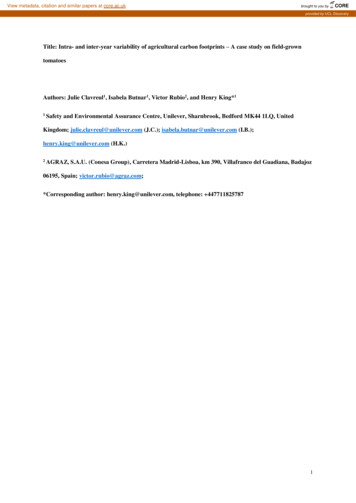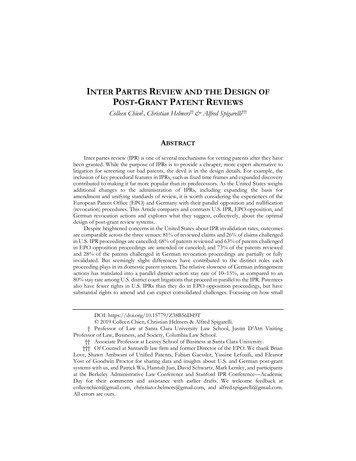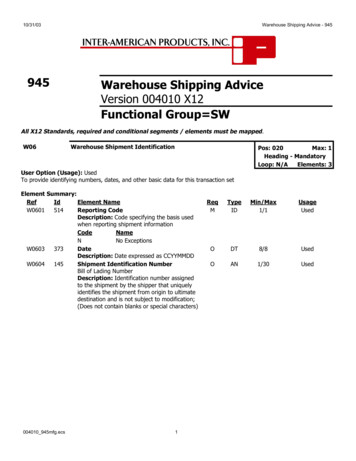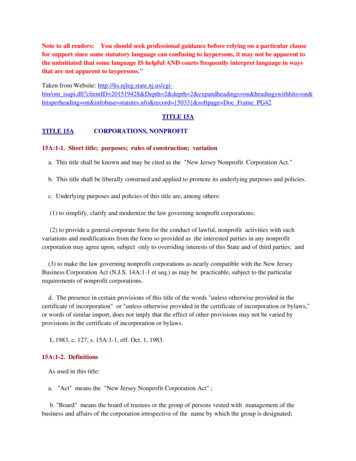
Transcription
View metadata, citation and similar papers at core.ac.ukbrought to you byCOREprovided by UCL DiscoveryTitle: Intra- and inter-year variability of agricultural carbon footprints – A case study on field-growntomatoesAuthors: Julie Clavreul1, Isabela Butnar1, Victor Rubio2, and Henry King*11Safety and Environmental Assurance Centre, Unilever, Sharnbrook, Bedford MK44 1LQ, UnitedKingdom; julie.clavreul@unilever.com (J.C.); isabela.butnar@unilever.com (I.B.);henry.king@unilever.com (H.K.)2AGRAZ, S.A.U. (Conesa Group), Carretera Madrid-Lisboa, km 390, Villafranco del Guadiana, Badajoz06195, Spain; victor.rubio@agraz.com;*Corresponding author: henry.king@unilever.com, telephone: 4477118257871
AbstractThe performance of agricultural systems and their environmental impacts can vary considerably within a singlecrop supply chain, due to differences in farming practices, soil properties, and yearly climatic conditions. In thispaper, we characterised the variability of carbon footprints of open-field tomato production by analysing acomprehensive farm dataset gathered over 4 years. We also assessed the importance of the different drivers ofvariability as compared to model uncertainties. The primary data used in this study were collected from 189farms from the Extremadura region in Spain and Portugal over a period of four years, from 2012 to 2015. Wemodelled the carbon footprint of these farms using the Cool Farm Tool model developed by Hillier et al. (2011)and conducted statistical analysis on the results to understand the relative importance of inter-year and intra-yearvariability. We performed sensitivity analysis to understand how sensitive the results were to variability in thefarmers’ input parameters and to the uncertainty in model parameters. This was done by varying all factors oneat-a-time, and then by running a Monte Carlo simulation where all uncertainties were propagatedsimultaneously. Results clearly show significant inter-year and intra-year variability in carbon footprints oftomato production within the study region. We observed approximately 20% variation for each annual carbonfootprint (intra-year variability), resulting in an overall 28% coefficient of variation in the aggregated footprintacross the different years. The carbon footprint of the whole tomato supply, calculated with the 4-year dataset,showed a weighted geometric mean of 51 kg CO2-eq/t and a weighted GSD of 1.32, meaning a 95% confidenceinterval of 29 to 89 kg CO2-eq/t. Results also show that small farms were characterised by a larger variabilitythan larger ones. This highlights the need to weight farm results by production volumes if the objective is toobtain a carbon footprint for the total production in a given region. The carbon footprint was found to be mainlysensitive to variability in farm practices, notably extent of pump irrigation and choice and amount of fertiliserused, with model uncertainties influencing the results to a relatively smaller extent. Further work is needed toextend these findings to other crops, regions and impact categories.KeywordsCarbon footprint; Uncertainty; Variability; Reporting; Agriculture; Tomato2
1IntroductionIn the context of growing consumer awareness of sustainability issues, corporate sustainability activities andreporting have expanded to cover full supply chains including agricultural production. Many companies haveimplemented sustainable sourcing initiatives to promote sustainable farming practices in their own or supplieroperations. While these strategies were primarily focused on management practices, they are starting to drive thecollection of farm data to generate the evidence of environmental performance and reductions in environmentalimpacts. For example, Unilever has developed a Sustainable Agriculture Code (SAC) 1, which definessustainable farming practices using 11 social, economic and environmental indicators (Unilever website).Compliance with the SAC is achieved through self-assessment and verification against the code, or compliancewith an external certification scheme with similar requirements. In terms of the former, suppliers are requestedto collect and submit farm data annually, in order to demonstrate sustainable farming practices and continuousimprovement. This includes an estimation of the life-cycle greenhouse gas (GHG) emissions from theiragricultural production using a recommended GHG calculator: the Cool Farm Tool (CFT, Hillier et al., 2011).Other companies also use the Cool Farm Tool (Cool Farm Tool website) or other similar tools (e.g. Diaterre,Farm Carbon Calculator, CALM, CCalc, or PalmGHG; see Colomb et al. 2012 and Whittaker et al. 2013 forreviews of such GHG calculators) to assess the GHG emissions of agricultural production and raw materialsupply.However, estimating GHG emissions of agricultural practices and evidencing progress over time presentschallenges that are not encountered when assessing impacts from industrial processes and energy systems. Thecarbon footprint of agricultural production can vary significantly between farms and from year to year and manyauthors, such as Sala et al. (2017), have stressed the need for more local assessments of crop production. This isbecause agricultural systems are, by nature, highly variable: weather conditions fluctuate; soil and topographicconditions vary from location to location and; genetic material and farming practices are influenced by factorssuch as local knowledge, socio-economic status of the farmer and local legislation. Therefore, the analysis andinterpretation of farm data collected through sustainable agriculture initiatives and certification schemes arechallenging, particularly if the objective is to benchmark performance and evidence improvement over time. Forthis, a better understanding of inherent variability and uncertainties in calculated emissions is required.1Abbreviations used in the article: CFT: Cool Farm Tool; CRM: Crop residue management; GM: Geometricmean; GSD: Geometric standard deviation; SAC: Sustainable Agriculture Code.3
A number of studies have started evidencing the variability of environmental impacts associated with specificcrop productions. Gerber et al. (2010) quantified the GHG emissions associated with global dairy productionand showed significant variability between regions and between production systems. Ntinas et al. (2017)showed how the carbon footprint of tomato production differs between various cultivation systems, based ondata collected over several months in two fields and five greenhouses located in Greece and Germany. PishgarKomleh et al. (2017) analysed the variability of the GHG emissions from open-field tomato production usingdata collected in 204 farms in two regions of Iran. They obtained a carbon footprint ranging between 0.1 and 0.4kg CO2-eq per kg tomato and showed that the performance in one region was systematically better than in theother one due to a combination of the use of modern irrigation system, less fertiliser use and better yields.Even though multi-year base periods are recommended (World Resources Institute, 2014), many studies ofagricultural production are based on data collected over periods shorter than a year as monitoring farm practicesover several years can be very resource intensive. Inter-year variability is however of high relevance whenassessing open-field agricultural production. Röös et al. (2010) quantified the uncertainty of potato productionin a region of Sweden and obtained a carbon footprint of 0.10–0.16 kg CO2-eq per kilogram of potatoes with95% certainty for an arbitrary year and field, which was reduced by 19% when the temporal variation waslocked to a specific year. Fedele et al. (2014) compared the performance of conventional and organic productionof barley and soybean in an Italian region and confirmed the importance of considering annual variations. Booneet al. (2016) analysed factors of variability in production systems of maize and showed that year-to-year weathervariation resulted in large differences in the environmental footprint. Even though more insights are gained onvariability of the environmental impacts between production systems, none of these previous studiessystematically addressed the separate influence of intra-year variability (differences between farms within oneyear due to e.g. soil conditions or farm practices) and inter-year variability (due to year-to-year weathervariations).In this study we made use of a large dataset collected at the farm level over a four-year period by the tomatoprocessor Agraz (part of Conesa Group), supplying Unilever with tomato products in accordance withUnilever’s SAC. A total of 189 quality-checked datasets from farms located in the Extremadura region acrossSpain and Portugal were analysed. The objectives of this study were to:1.Characterise the intra- and inter-year variability in the carbon footprint of tomato production in thestudy region,4
2.Employ sensitivity and uncertainty analysis methods to systematically assess how parametervariability and model uncertainties respectively influence variability in the carbon footprint,3.Elaborate on the implications of our findings in terms of best practice for farm data collection andcarbon footprinting of crop production.2Materials and Methods2.1 Farm data collectionData were collected over 4 years by Agraz from open-field tomato cultivating farms located in the Extremaduraregion across Spain and Portugal. All farms under contract with Agraz are operated according to the SACguidelines for farming practices. In total, 189 datasets were collected: 31 in 2012, 42 in 2013, 60 in 2014, and 56in 2015. Each year, the reporting farms were selected randomly from within Agraz’s farmer base, as required bythe SAC. Small and large farms were included with production areas varying from 0.3 to 231 ha and annualproduction from 24 to 19,500 tonnes per year (Figure 1).Farm-specific variables were collected, reviewed and input in the CFT, an Excel-based tool developed by Hillieret al. (2011), including factors such as the types and amounts of fertiliser used, the amount of diesel used, andthe production yield. Before running the carbon footprint calculations in the CFT, we run a second check toensure the results did not have gross mistakes e.g. in reporting units, and spotted if some data points were wronge.g. with regards to fertiliser reporting. Table 1 shows the full list of variables collected and the ranges of valuesobserved in the farms sampled over the four years and distributions are presented for selected variables in FigureS1 of the Supplementary Information (SI).2.2 Carbon footprint assessmentThe carbon footprints of the 189 sampled farms were estimated by using the CFT model (Hillier et al., 2011). Thistool was recently rated as the best carbon accounting tool for arable crops by Whittaker et al. (2013) due to itsuser-friendliness, transparency and comprehensiveness. The CFT takes an attributional life cycle assessment(LCA) approach, estimating the carbon footprint of a crop based on the following parameters: (i) farm conditions,i.e. location, climate, soil parameters (soil moisture, drainage, pH, soil organic matter); (ii) material and energyinputs to farming, i.e. fertiliser and pesticide types and amounts and energy used on farm and; (iii) efficiency ofthe farm, i.e. area harvested and volume of fresh tomato produced.5
The system boundary for this study was the farm gate (Figure 2) and included the preparation of land, transplantingof the seedlings in the field, growing the plants, fertiliser and pesticide application, irrigation, harvesting, andmanagement of crop residues. Nursery operations were excluded as these are a minor contributor to the carbonfootprint of the crop. The production of capital goods was excluded (Hillier et al., 2011), as well as the impactsfrom land use change as this happened more than 20 years ago (BSI PAS 2050, 2011). Primary data from thefarms (Table 1) were paired with secondary data taken from the CFT (Hillier et al., 2011), including inventoriesfor production of fertilisers and pesticides, production of energy carriers, i.e. electricity and diesel, and emissionfactors for estimating field emissions and diesel burning (Table 2). All equations and related parameters areprovided in SI.2.3 Statistical methods for characterising the variability in carbon footprintsAn arithmetic mean is the simplest way of describing central tendencies, but it can be influenced by outliers orskewed data. Geometric characteristics are better suited for skewed distributions such as the ones observed formost parameters in this dataset. LCA practitioners often use lognormal distributions for intermediate andelementary flows (Weidema et al., 2013) which are associated with geometric mean and standard deviation. Herewe decided to present both arithmetic and geometric characteristics of the dataset as readers may be morefamiliar with the arithmetic metrics. Equations 1-4 show the arithmetic mean (µ) and standard deviation (σ) of aset of n numbers xi i 1 , as well as the geometric mean (GM) and standard deviation (GSD). Note that 95%nconfidence intervals were defined for normal distributions as [ µ - 2*σ - µ 2*σ ], and for lognormaldistributions as [ GM / GSD2 – GM*GSD2 ].n xii 1(1)nn (xi 1i )2(2)n 1n ln( x )GM exp( i 1in)(3)6
nxi (ln( GM ))GSD exp(i 1n 12)(4)As observed in Figure 1, the size of the farms sampled varied significantly. To account for this, volumeweighted means and standard deviations were used. Equations 5-8 specify how they were calculated, wi i 1nbeing the production volumes associated with the carbon footprints xi i 1 .nn w x *wii 1i(5)nn w (x i 1iw)2(6)n 1 n* win i 1nGM w exp( w * ln( x )ii 1in w(7)ii 1nGSDw exp()xi w * (ln( GMi 1)) 2iwn 1 n* wini 1) (8)Distribution fitting was performed with the @RISK software (PALISADE website) which provides the Akaikeinformation criterion for any chosen distribution type.2.4 Methods for sensitivity and uncertainty analysesSensitivity analysis was performed to understand the sensitivity of the GHG emissions to the variability in thedifferent input parameters (for both farmer’s inputs and model parameters). A one-factor-at-a-time techniquewas used:7
1.GHG emissions per tonne were first calculated for an “average farm” defined with median valuesfor all parameters,2.Then GHG emissions per tonne were calculated using extreme (minimal and maximal) values foreach parameter, one at a time: the values used were actual minimal and maximal values observed inthe 189 farm datasets for all farmer input variables, and minimal and maximal values found inliterature for model uncertainties.Tables 1 and 2 present the values used for all parameters in the sensitivity analysis. To simplify calculations, theuse of fertilisers was limited to one fertiliser type: “Compound NPK”, and represented solely by the totalamount of nitrogen input (kg N per ha) and the content of nitrogen within the fertiliser (%). The amount offertiliser input (kg fertiliser per ha) was then back-calculated. This was deemed reasonable since the“Compound NPK” fertiliser type represented 91% of all fertiliser use over all 189 farms, the remaining 9%being compound NK, ammonium nitrate or in some rare occasions potassium sulphate, calcium nitrate, calciumammonium nitrate, poultry layer manure, super phosphate or sheep farmyard manure. In addition, the carbonemission factor of compound NPK lies within the medium range of the emission factors of other fertilisers.We used mostly the information found in Hillier et al. (2011) to set minimal and maximal values for all modelparameters (See last column of Table 2). The CFT uses the model by Bouwman et al. (2002) for estimatingemissions of N2O, NO and NH3. Bouwman et al. (2002) specifies that the 95% confidence interval for N2Oestimates is [-40%; 70%], which we used, but they could not assess the uncertainty around the estimations ofNO and NH3 due to a lack of data. We arbitrarily assumed the same 95% confidence interval for NO and NH 3 asfor N2O, and added for them the uncertainty in the conversion to N2O as given by IPCC (2006). We employedthe same approach for the leaching-related emissions.Subsequently, uncertainties in all variables were propagated jointly using a Monte Carlo sampling. Parameters’distributions were selected to fit best to the reality: lognormal distribution for most continuous parameters (fittedto observed data) and discrete probabilities for the discrete parameters such as soil moisture. Tables 1 and 2present all assumptions used for primary and secondary data respectively. Three sets of 10,000 simulations wererun: first, only the variability in farmer’s inputs were propagated (primary data from Table 1), then only modeluncertainties (secondary data from Table 2), and finally all uncertainties and variability together.8
3Results and discussion3.1 Variability in the carbon footprints of the sampled farmsThe carbon footprint of the whole tomato supply, calculated with the 4-year dataset, showed a weightedgeometric mean of 51 kg CO2-eq/t and a weighted GSD of 1.32, meaning a 95% confidence interval of 29 to 89kg CO2-eq/t. These results were expressed with geometric characteristics since the carbon footprint results wereslightly skewed as confirmed by distribution fitting performed with the @RISK software (PALISADE website).Arithmetic means were found systematically higher than geometric ones due to the positive skewness of thedataset (See Table 3). The results were weighted by production volumes because, as can be observed from the189 farm results presented on Figure 3, minimum and maximum results were usually found for smaller ratherthan larger farms. Weighting farm results by the associated production volumes therefore significantlydecreased standard deviations as confirmed in Table 3. When weighting by production volumes larger farmshave more weight in the resulting carbon footprint, providing a more accurate estimate for the tomato supplythan when all farm results were weighted equally regardless of their size. On the other hand, unweighted resultscan be useful if one wants an overview of farming practices regardless of the size of the farms, e.g. todemonstrate change of farming practices within a region or to know the performance of individual farms. Thevolume-weighted estimate is therefore more relevant to buyers and users of tomatoes whereas the non-weightedone is more useful to contractors and growers.Our results of 51 kg CO2-eq per t tomato are comparable with the results obtained by Karakaya & Ozilgen(2011) and Ntinas et al. (2017) for open-field production of industrial tomatoes in Turkey (67 kg CO 2-eq per ttomato2) and Greece (72 kg CO2-eq per t tomato) respectively. However, they lie in the lower range of the datagenerally found in literature for tomato production. The review by Clune et al. (2017) reported a range of 80 to1000 kg CO2-eq per t tomato with a mean of 460 kg CO2-eq per t tomato, based on 19 LCA studies. Differencesin production systems and system boundaries can partly explain the variation. For example, Jones et al. (2012)obtained a carbon footprint of 190-270 kg CO2-eq per t tomato for open-field tomato production in Florida. Thehigher results can be attributed to factors such as a higher nitrogen input per hectare, the use of plastic mulchand inclusion of post-farm gate transportation. Pishgar-Komleh et al. (2017) also reported values of 100-400 kgCO2-eq per t tomato for 204 Iranian open-field tomato farms and these were driven by high energy consumptionfor pump irrigation and biogenic carbon emissions linked to recent land use change. In comparison the farms2All results are presented in kg CO2-eq per t tomato for the purpose of comparability.9
reported this paper are all well-established farms with no land use change in the last 30 years, and operatingunder sustainable agricultural farming practices and with less energy required for irrigation than in the Iraniancase.3.1.1 Contribution analysisGHG emissions originated mostly from fertiliser production (45% on average), on-farm energy consumption(30%) and direct N2O field emissions (11%), while background N2O emissions, pesticides production and use,and crop residues management contributed relatively less to total GHG emissions, 4%, 3% and 7% respectively.Figure 4 shows the GHG emissions of all processes aggregated in six groups: background N2O emissions(background), direct field N2O emissions (field), fertiliser production (fertiliser) which includes productionprocesses of the different types of fertilisers used by the farms, pesticide production and use (agrochemicals),on-farm energy consumption (energy) which includes both diesel consumption for agricultural machinery anddiesel and electricity consumed for running the irrigation pumps, and crop residue management (CRM). Thegreatest contributors to the carbon footprint (fertiliser production and on-farm energy use) also showed thelargest variability. For fertilisers, this was mostly explained by the differences in the quantity of nitrogen appliedon land and by the different types of fertiliser used by individual farms. The choice of fertiliser combination touse each year is made by the farmer to optimise yields and the use of the CFT highlights the wider GHGimplications of such management decisions. For energy-related emissions, the differences were due to thedifferent irrigation systems used by farmers, i.e. conventional vs. drip irrigation, powered by either diesel orelectric motors, depending on the farm. Conventional irrigation systems were found to be more energy intensivethan drip irrigations systems that circulate and use less water, irrespective if the farms used diesel or electricpumps. This contribution analysis highlighted the key activities for GHG management in tomato production inthis region, indicating that efforts should be focused on optimising the choice and use of fertilisers and theefficiency of the irrigation system. The large contribution of energy (for irrigation) and fertiliser uses washighlighted as well by Pishgar-Komleh et al. (2017) and Ntinas et al. (2017).3.1.2 Inter-year variability of GHG emissions from tomato productionResults presented in Figure 3 clearly show that both the intra-year and inter-year variabilities are significantwhen assessing the carbon footprint of tomato production within a single region. The level of variability10
observed in this study is particularly interesting since all farmers in our sample worked with the same supplier(Agraz) and complied with the same set of best management practices, as laid out in the SAC.Figure 3 shows that the 2014 production had the lowest GHG emissions as opposed to the 2013 dataset whichshowed the highest impacts. This was confirmed by the weighted geometric means presented in Table 3, wherethe largest difference was observed between the 2013 and 2014 datasets (49% difference). The 2013 resultscould be explained by bad weather conditions that year that resulted in lower yields and higher use of fertilisers.We ran a statistical analysis using both an ANOVA on the full dataset and two-sample t-tests, which weconsidered valid even if t-tests assume normal distributions and the dataset was slightly skewed. The statisticalanalysis confirmed that, despite the intra-year variability, all annual datasets were significantly different with asignificance level of 0.90, and therefore it evidenced the importance of the year effect for this dataset.In addition, the spread of GHG emissions per tonne of tomato produced varied depending on the year: it was, forexample, much larger for the 2013 dataset than for the 2014 dataset. This was confirmed by the standarddeviations presented in Table 2, where the coefficients of variations varied between 22% and 33%, and pointedto the influence of weather conditions as a major driver for production and GHG performance.The results show that, for this dataset, intra-year and inter-year variability had an equivalent importance. Indeed,the coefficient of variation between the four yearly weighted arithmetic means was 20%, a similar magnitude tothe coefficients of variation (weighted arithmetic) calculated within each year, which were between 19 and 24%.The full dataset, which combined intra-year and inter-year variability, had a coefficient of variation equal to28% (weighted).3.2 Sensitivity and uncertainty analysesThe variability of carbon footprints observed in Figure 3 is due to many factors. Although some of theexplanations were revealed by the contribution analysis or by the observation of the 189 single GHG resultspresented in Figure S1, no simple correlation could be drawn between the variability in just one or a few ofthose parameters and the variability in the total carbon footprints. It is interesting to note in particular fromFigure S1 that the farms’ carbon footprints per tonne were not correlated with their sizes.The objectives of the sensitivity analysis were to quantify the importance of each individual parameter (bothprimary and secondary data) in determining the farm’s GHG emissions and to verify if the variability observed11
in the primary data is a bigger contribution to the variability in total carbon footprint than the uncertainty in themodel parameters.Figure 5 presents the total GHG emissions per tonne of tomato produced, when individually varying the valuesconsidered for each parameter, using the minimal and maximal values presented in Tables 1 and 2. Wedistinguished between parameters collected at farm level for which minimal and maximal reported values wereused (underlined in Figure 5, input parameter variability from Table 1), and model parameters for which weused literature estimates of uncertainty and variability (from Table 2). The results indicated that the variabilityof total GHG emissions per tonne of tomato produced was very sensitive to variations in the production yield, inline with what other studies showed, e.g. Röös et al. (2010). For example, a 70% reduction in the productionyield induced a threefold increase of the GHG emissions per tonne of tomato. In general, GHG emissions werefound to be mainly sensitive to variability in farm practices (underlined in Figure 5), in particular to the onesrelated to fertiliser and diesel uses (confirming the variability observed in Figure 4). A 269% increase innitrogen input on the field (kg N per ha) implied a 205% increase in the GHG emissions of the tomatoproduction. The influence of model uncertainties on the GHG results was found to be relatively lower. Only thecarbon emission factor from fertiliser production was found to be of importance due to the high contribution offertiliser use to the impact. The use of the highest value for fertiliser production (2.5 kg CO 2-eq per kg fertiliser)lead to a 70% higher GHG emission result than when using the default (0.96 kg CO 2-eq per kg fertiliser).The combined effects of all sources of uncertainties and parameter variability were analysed by running threeMonte Carlo simulations, each with 10,000 random samples. Results presented in Figure 6 show that thedistribution obtained by propagating only variability in farmers’ input parameters was more spread (standarddeviation of 20 kg CO2-eq/t) than the one with only model uncertainties implemented (st. dev. of 11 kg CO2eq/t). This confirms that the impact of the variability in the farmers’ input parameter was more important thanthe impact of model uncertainties in this case study, as also observed in Figure 5. This result is important andhighlights the fact that efforts should be focused on collecting sufficient amounts of farm data when buildingcrop production datasets or databases, and that model uncertainties are relatively less important. The distributionobtained by propagating all uncertainties was (as expected) the most spread (standard deviation of 27 kg CO2eq/t) because it was the result of the joint propagation of variability in farmer’s input variables and of modeluncertainties. Overall, the non-weighted coefficient of variation increased from 36% when only farmer-specificvariabilities were implemented, to 49% when model uncertainties were considered as well. Note that thesecoefficients of variation are different from the ones reported in Section 3.1, as here they are a result of the12
Monte Carlo simulation using a distribution for each individual parameter, while the coefficients of variationpresented in Table 3 reflected the actual variation between the farms’ individually reported GHG emissions.3.3 Implications for data requirements and carbon footprintingThe study has shown that the variability of the parameter values collected at the farm level was critical whenassessing the carbon footprint of tomato production within one region. It is therefore crucial to collect enoughdata over several years in order to represent correctly the diversity of practices within a crop supply chain. Itwas then reasonable to consider what a representative sample should include, i.e. how many farms should beconsidered, and how many years’ worth of data are required. Even though we presented here a specific casestudy, general conclusions could be drawn from this analysis for the amount of data required for getting a robustestimate of the carbon footprint of an agricultural product.To assess how much data would be required to account for intra-year variability, we performed bootstrapping ofthe GHG emission results within each year. This consisted of randomly selecting one farm at a time andevaluating at each step the weighted geometric mean of all selected farms. Repeated application of thistechnique allowed us to establish the number of farms after which the collection of additional farm data did notaffect the final result much, because of the inherent variability.Figure 7
For example, Unilever has developed a Sustainable Agriculture Code (SAC)1, which defines sustainable farming practices using 11 social, economic and environmental indicators (Unilever website). Compliance with the SAC is achieved through self-assessment and veri











